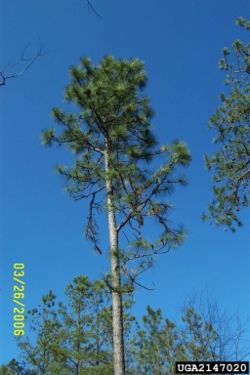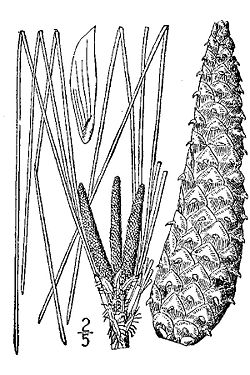Longleaf pine
| Longleaf pine |
|---|

|
| Scientific Classification |
|
| Anatomical Drawing |
Longleaf Pine (Pinus palustris) is an evergreen conifer tree. It's habitat is the along Atlantic and Gulf coastal plains to sotheastern Virginia, central Florida and west to eastern Texas. It grows in north and central Georgia and Alabama. Other common names: longstraw pine, yellow pine, southern yellow pine, longleaf yellow pine, and Georgia pine.
Antamoy
Longleaf Pines are medium to large sized trees, and have the ability to reach over 100 ft. (30.5-36.6 m) when mature. Longleaf Pines can live for 40 to 50 years. Longleaf Pines normally have a very straight trunk. It's bark is scaly and the color varies from orange-brown to gray, and they eventually grow flat plates. Needles are 8-18 (20-46 cm) inches long, three needles per fascicle, and are usually tufted at the end. Cones are 6-8 (15-20 cm) inches long. Longleaf Pine tree buds are a silky white, and it's seed is the largest of all southern pines.
Reproduction
Longleaf Pine is monoecious. It begins producing cones at the age of about 30 years of age or when it reaches 10 inches (25 cm) in diameter. Longleaf Pine seeds develop in a 3-year process. Strobili emerge during midsummer. Conelets emerge in late winter. Catkins emerge in November and remain dormant to late winter. Pollination occurs from late February in the South to early April in the North. Fertilization does not occur until the following spring. Cones reach maturity at their second year in growth in mid-September to mid-October. The seeds are dispersed from late October to November the majority usually within 2 to 3 weeks. Seed germinates 1 to 2 weeks later, and the primary needles appear quickly after germination and secondary needles about 2 months later. Seedlings are stemless after one growing season and develop into a "grass-stage" that lasts from 2 to more years.
Ecology
Longleaf Pine wood was once used in extend for timber and ship lumber because of the few defects it has and it's straightness. It is not used like it once was because Longleaf Pines are not as easy to regenerate as other southern pine species.
Longleaf pines provide an excellent environment for bobwhite quail, white-tailed deer, wild turkey, and fox squirrel. Many species of birds can benefit from Longleaf pine forests. Old Longleaf pines provide a nesting environment for the red-cockaded woodpecker. Birds, mice, squirrels, and other small mammals eat the tree's seeds. Ants eat germinating seeds, and razorback hogs eat the roots of seedlings.
Gallery
 Browse |







